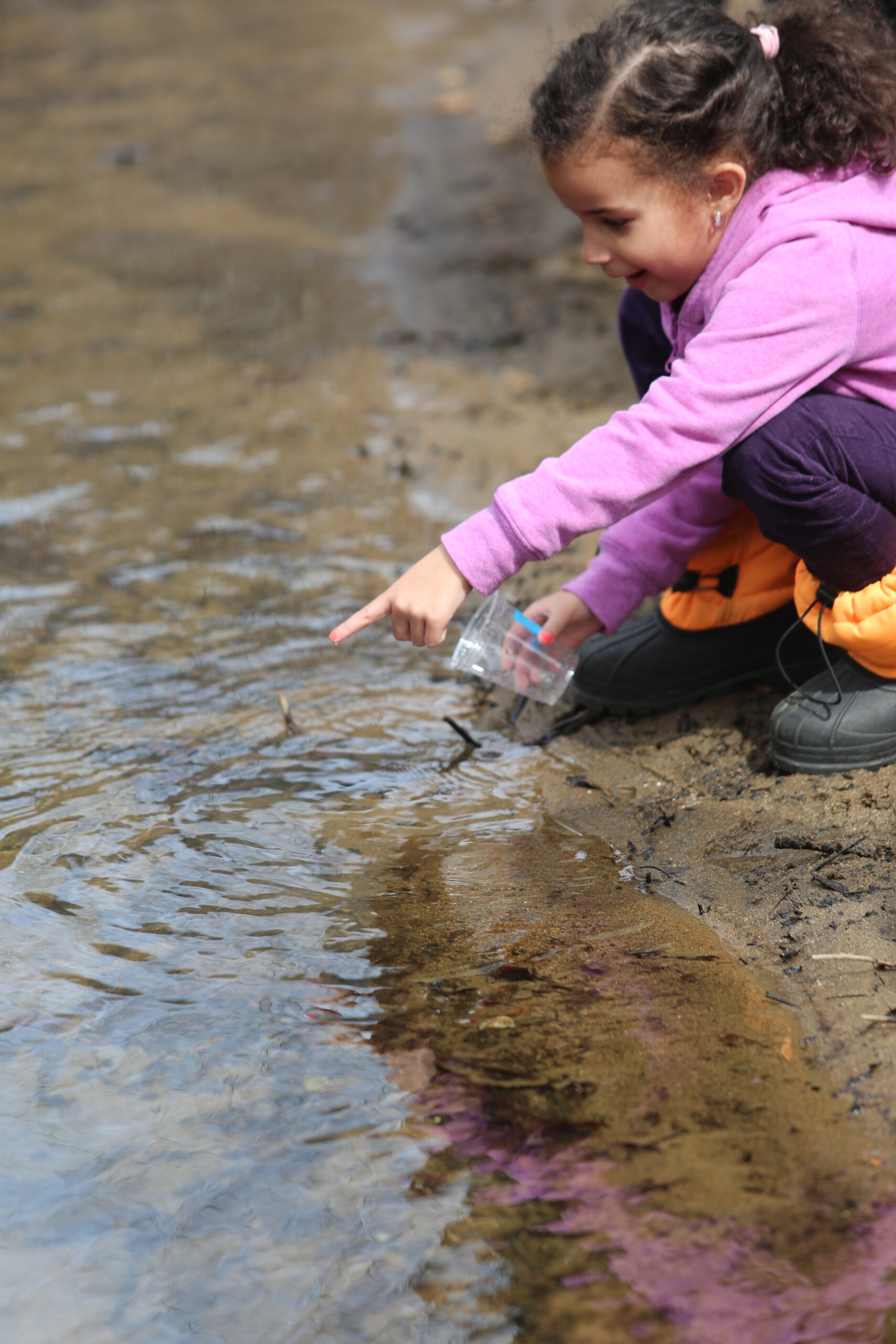Extracted and adapted from the Vermont TIC Manual, 9th Edition (2021)
Your plans for Release Day should be based on several considerations:
- How much field work have your students been able to do over the year?
- How accessible is stream that will support brook trout?
- Can you arrange needed transportation?
- How many volunteers can you recruit?
In most cases, a great Release Day program includes activities like the following:
- A stream habitat study consisting of:
- Assessing water chemistry and the physical characteristics of the stream; and
- Collecting and identifying stream macro-invertebrates and other critters
- A discussion of conservation issues
- Trout Games
- Fly casting or fly tying experience
- Trout Release
To implement the above optimal release program, it is useful to set up 5 activity stations with a maximum of 12 students rotating through a station at any one time, plus a trout release station involving the entire student group. Capping the number of students at 12 for each activity station (except the trout release event) promotes full participation in the activity. Thus, the optimum number of students at a release program is 60 at any one time.
In the Optimal Release Program conceptualized below, asterisks [*] denote particularly high priority activities. They comprise the core of the release program.
THE STATIONS #
Station 1 – Home Sweet Home* #
A blind comparison test of the water parameters in a sample of water from:
a. the stream receiving the trout
b. water from the cooler containing the trout
c. a nearby stream that is not approved for releasing the trout
The water parameters should include a measurement of water temperature and tests for ammonia, nitrites and pH. A test for dissolved oxygen (DO) is optional if you have the equipment to do so. In addition, it would be valuable for the students to visually estimate the turbidity of the stream water and measure stream flow.
(See section G, 1, b and G, 1, c for needed equipment.)
Station 2 – What’s for Dinner?* #
A student survey of the macro-invertebrates in the stream and an examination of plants, insects and other critters found on or near the stream bank.
Station 3 Teacher-organized games #
relating to conservation such as Web of Life, Who’s Your Daddy?, Macro Mayhem, Food Web Tag, Geo Caching, etc.
Station 4 Specialist-led discussion of conservation issues #
1. The factors affecting stream quality, e.g., impervious surfaces, erosion, storm drains, culverts, trash, and garbage
2. The impact of people on trout.
3. How nature produces the effects of the chiller, aerator, and filter used in the tank.
A naturalist-led stream walk could be both an enjoyable and instructive part of a release program. State or local organizations or agencies may have a staff naturalist who could lead such a walk if given sufficient advance notice.
Station 5 Angling Demonstration #
Volunteers demonstrate fly tying and casting; students try casting and fly tying. (See below for needed equipment.)
Station 6 Releasing trout into the stream by the students #
This station is an integral part of the TIC program for two reasons. Releasing the fingerlings provides closure to the students and reinforces the link between conditions in the tank and in the natural world that the trout will inhabit. Also, at this station, the required count is made of the number of fingerlings released so that the Vermont Department of Fish and Wildlife can get an accurate tally of yearly TIC releases by stream. (See below for needed equipment.)
SAMPLE AGENDA FOR TROUT RELEASE PROGRAM #
9:15 – 9:45 AM: Students arrive with fingerlings in coolers bearing school identification
9:45 – 10:00 AM: Welcome and overview of day’s activities
10:00 – 11:00 AM: Two 25-minute sessions with 5 minutes between each.
11:00 – 12:00 PM: Trout releases. This release schedule includes time for acclimating the fingerlings to the stream water.
12:00 – 12:30 PM: Lunch
12:30 – 2:00 PM: Three 25-minute sessions with five minutes between each session.
2:00 – 2:15 PM: Closing Ceremony including a report of the number of trout released by school; students and teachers clean up trash and depart
2:15 – 2:45 PM: Volunteers complete clean up and depart.
SAMPLE SCHEDULE FOR MULTIPLE SCHOOL PARTICIPATION IN A TROUT RELEASE #
Program
| TIME | Station 1: Home Sweet Home | Station 2: What’s for Dinner? | Station 3:Food WebActivity | Station4:Conservation Discussion | Station 5:Fly tying/ casting |
| 10:00 AM to 10:25 AM | Group A | Group B | Group C | Group D | Group E |
| 10:30 AM to 10:55 AM | Group D | Group E | Group A | ||
| 11:00 AM to 12:00 PM | RELEASE OF TROUT | ||||
| 12:00 PM to 12:30 PM | LUNCH | ||||
| 12:30 PM to 12:55 PM | Group C | Group D | Group E | Group A | Group B |
| 1:00 PM to 1:25 PM | Group D | Group E | Group A | Group B | Group C |
| 1:30 PM to 1:55 PM | Group E | Group A | Group B | Group C | Group D |
| 2:00 PM to 2:15 PM | CLOSING CEREMONY | ||||
EQUIPMENT NEEDED #
1. For arrival at stream and water testing:
a. for arrival
1. 2 or 3 aquarium nets (6×4 inches)
2. 10-gallon cooler
3. Battery-operated aerator
4. Bottles of frozen de-chlorinated water
b. water testing
1. water testing kit.
2. 3 clean jars for the water samples
3. digital thermometer
c. estimated stream flow
1. watch with second hand
2. floating bobber or ball to indicate distance traveled in elapsed time; measuring tape to establish stream flow distance.
2. For a study of animal and plant life in the stream;
a. kick seine
b. hip boots (optional)
c. table and chair
d. white plastic sheet or cutting board for specimens
e. turkey baster to siphon up macro-invertebrates
f. clear bowls and specimen jars for samples
g. magnifying hand-held viewer box (Acorn Naturalists, T-2345 or equivalent), magnifying glasses. Laminated macro ID charts available from IWLA or other sources.
3. For the angling demonstration
a, rods and reels
b. lures, flies, and fly-tying equipment
4. For the trout release and count
a. 12-oz. cups to carry fingerlings to stream
b. Small net to capture fingerlings in cooler and place into cups






